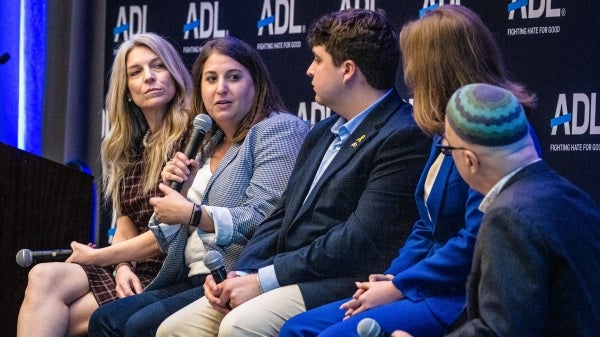Event examines importance of key slice of research funding, what NIH’s indirect cost cap might mean

Bhaven Sampat, professor for Arizona State University’s School for the Future of Innovation in Society and the School of Public Affairs, explains the process of negotiating indirect cost rates at a May 20 event at ASU's Barrett & O’Connor Washington Center. Courtesy photo
On Feb. 7, the National Institutes of Health announced a 15% cap on indirect cost rates on university research, a policy change that sent a strong ripple of concern through an already anxious scientific community.
“Indirect costs” is the label used to identify expenses not singularly attributable to any one project — facilities costs (research labs), utilities, environmental health and safety, IT and administrative support, etc.
This essential infrastructure to support research accounts for at least 25% to 30% of federal research expenditures, according to Bhaven Sampat, who spoke at a recent Arizona State University event held by the Consortium for Science, Policy & Outcomes titled “Rethinking the NIH: Indirect Cost Recovery Policy.”
Since many of these costs are essentially shared, a part of many projects rather than exclusive to one, researchers include a negotiated indirect cost rate to each funder or grantee. This mechanism, referred to as indirect cost recovery (ICR), provides resources that universities need to help keep the lights on and research labs running. Changing the funding of indirect costs changes the economics of research at universities across the country.
Although the sudden announcement and arbitrary cap came as a surprise, the topic is not new, and neither are the calls for change.
A research associate at the National Bureau of Economic Research, Sampat has spent years researching the long and convoluted history of shifting indirect cost rates, publishing his most recent research in an April paper titled “Indirect Cost Recovery in U.S. Innovation Policy: History, Evidence, and Avenues for Reform.”
In his research, Sampat and his team collected data on more than 350 institutions receiving NIH funding over the past 20 years to analyze how changing ICR could impact universities and institutions. The event at the ASU Barrett & O’Connor Washington Center allowed students and professionals alike to digest Sampat’s research and discuss new policy options, like a higher flat ICR rate, benchmarked rates using peer overhead costs, and others.
To ground the discussion with the event attendees, Sampat shared four takeaway facts from his research:
- When looking at the NIH, effective rates of indirect costs are significantly lower than negotiated rates. Because of this, policymakers should be looking at effective rates when setting caps, Sampat said.
- Universities have lower ICR rates than other NIH grantees.
- Negotiated ICR rates have been on the rise since 1980 — likely the cause of some controversy surrounding this model. Effective rates have remained relatively stable.
- Current effective ICR rates at different universities appear constant regardless of rank, endowment or NIH direct cost funds at each university.
“I don't think we've solved any problems here, but I think the data that we have been able to assemble will inform at least certain parts of the debate,” Sampat said at the event.
The debate over ICR policy dates back to World War II and has remained a topic of discussion in research grants ever since. When leaders debated indirect costs in the 1940s, they realized that “if they just pay the direct cost of research and don't pay for the underlying infrastructure, that it's going to disrupt universities and may disincentivize participation,” Sampat explained.
When the NIH announced the 15% cap on indirect costs in February, concerns emerged that it would negatively impact the research being done at institutions and universities across the country. According to Sampat’s research, universities would suffer the most under the new cap — losing 15% to 20% of their annual NIH funding, on average, as a result of the change.
Although ICR has faced controversy over years, capping the program at 15% would undoubtedly undermine scientific research at institutions across the country, explained CSPO Director Arthur Daemmrich, and cuts to the NIH itself also threaten the country’s medical and health research infrastructure.
“The NIH is the largest intramural biomedical research campus in the world, the largest extramural funder of grants, the most Nobel laureates associated with an institution are funded by it, most labs, most institutes, and on and on,” Daemmrich said.
“This spring, perhaps for the first time in its 130 years, (the NIH) faced very serious cuts and a very serious reassessment of its structure, its organization and of indirect costs.”
There are several reasons that policymakers want to reform the ICR system, Sampat said. But aggressively capping the ICR would have the opposite effect of what policymakers, and society at large, really want, which is ultimately advancing research.
“The concern, then, I think, is just that with this cut, you may cut into some muscle,” Sampat said.
The event was the fourth in a “Rethinking Science, Policy” series by the Consortium for Science, Policy and Outcomes. For information, visit cspo.org.
More Local, national and global affairs

Arizona public universities work together to predict housing insecurity before homelessness strikes
The words “housing insecurity” conjure up the image of a family living in a car after losing their home, frantically seeking an affordable new place to live.What if there was a way to predict housing…
A record 10 ASU students awarded US Department of State’s Critical Language Scholarship
Ten Arizona State University students have been selected for the highly competitive Critical Language Scholarship, or CLS, program — an initiative of the U.S. Department of State that aims to…

Putting hope above hate at antisemitism conference
Hatred and hope were the overarching themes of the “Rising Above Together” conference hosted April 11 by the Anti-Defamation League in partnership with Arizona State University.Hatred: According to…